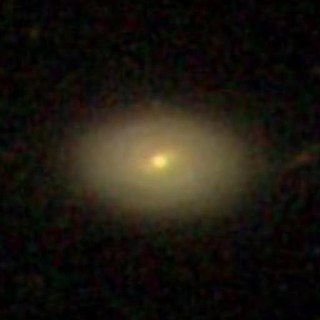
NGC 7057 is an elliptical galaxy located about 230 million light-years away in the constellation of Microscopium. NGC 7057 was discovered by astronomer John Herschel on September 2, 1836.

NGC 7070A is a face-on lenticular galaxy located about 100 million light-years away in the constellation of Grus.

NGC 7079 is a barred lenticular galaxy located about 110.58 million light-years away in the constellation of Grus. NGC 7079 is also classified as a LINER galaxy. It is tilted about 51° to the Earth's line of sight. NGC 7079 was discovered by astronomer John Herschel on September 6, 1834.

NGC 498 is a lenticular galaxy located about 260 million light-years away from Earth, in the constellation Pisces. NGC 498 was discovered by astronomer R. J. Mitchell on October 23, 1856.

NGC 4586 is a spiral galaxy located about 50 million light-years away in the constellation Virgo. The galaxy was discovered by astronomer William Herschel on February 2, 1786. Although listed in the Virgo Cluster Catalog, NGC 4586 is considered to be a member of the Virgo II Groups which form a southern extension of the Virgo cluster. NGC 4586 is currently in the process of infalling into the Virgo Cluster and is predicted to enter the cluster in about 500 million years.

NGC 679 is an elliptical or a lenticular galaxy located 210 million light-years away in the constellation Andromeda. The galaxy was discovered by astronomer William Herschel on September 13, 1784 and is a member of Abell 262.

NGC 709 is a lenticular galaxy located 150 million light-years away in the constellation Andromeda. It was discovered by the Irish engineer and astronomer Bindon Blood Stoney on October 28, 1850 and is a member of the galaxy cluster Abell 262.

NGC 753 is a spiral galaxy located 220 million light-years away in the constellation Andromeda. The galaxy was discovered by astronomer by Heinrich d'Arrest on September 16, 1865 and is a member of Abell 262.

NGC 759 is an elliptical galaxy located 230 million light-years away in the constellation Andromeda. NGC 759 was discovered by astronomer by Heinrich d'Arrest on September 17, 1865. It is a member of Abell 262.

NGC 4060 is a lenticular galaxy located 320 million light-years away in the constellation Coma Berenices. It was discovered by astronomer Albert Marth on March 18, 1865 and is a member of the NGC 4065 Group which is part of the Coma Supercluster.

NGC 4076 is a spiral galaxy located 290 million light-years away in the constellation Coma Berenices. The galaxy was discovered by astronomer William Herschel on April 27, 1785 and is a member of the NGC 4065 Group.

NGC 4093 is an elliptical galaxy located 340 million light-years away in the constellation Coma Berenices. The galaxy was discovered by astronomer Heinrich d'Arrest on May 4, 1864. NGC 4093 is a member of the NGC 4065 Group and is a radio galaxy with a two sided jet.

NGC 973 is a giant spiral galaxy located in the constellation Triangulum. It is located at a distance of circa 200 million light-years from Earth, which, given its apparent dimensions, means that NGC 973 is about 230,000 light years across. It was discovered by Lewis Swift on October 30, 1885.

The NGC 4065 Group is a group of galaxies located about 330 Mly (100 Mpc) in the constellation Coma Berenices. The group's brightest member is NGC 4065 and located in the Coma Supercluster.

NGC 765 is an intermediate spiral galaxy located in the constellation Aries. It is located at a distance of circa 220 million light years from Earth, which, given its apparent dimensions, means that NGC 765 is about 195,000 light years across. It was discovered by Albert Marth on October 8, 1864. The galaxy has an extensive hydrogen (HI) disk with low surface brightness, whose diameter is estimated to be 240 kpc.

NGC 4513 is a lenticular galaxy and a ring galaxy located about 110 million light-years away in the constellation Draco. It was discovered by astronomer Heinrich d'Arrest on October 16, 1866.

NGC 3937 is an elliptical or a lenticular galaxy located about 310 million light-years away in the constellation Leo. It was discovered by astronomer William Herschel on April 27, 1785 and is classified as a radio galaxy.

NGC 5910 is an elliptical galaxy located about 540 million light-years away in the constellation Serpens. It was discovered by astronomer William Hershel on April 13, 1785. NGC 5910 is also a strong radio source with a conspicuous nuclear jet.
The Telescopium−Grus Cloud is a galaxy filament in the constellations of Pavo, Indus, and Telescopium. It was first defined by astronomer Brent Tully in his book The Nearby Galaxies Atlas and its companion book The Nearby Galaxies Catalog.
The Southern Supercluster Strand is a galaxy filament that incompasses the Southern Supercluster and the Telescopium−Grus Cloud.


















